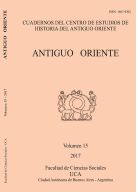Por favor, use este identificador para citar o enlazar este ítem:
https://repositorio.uca.edu.ar/handle/123456789/7249| Campo DC | Valor | Lengua/Idioma |
|---|---|---|
| dc.contributor.author | Ben David, Chaim | es |
| dc.date.accessioned | 2019-06-20T00:03:34Z | - |
| dc.date.available | 2019-06-20T00:03:34Z | - |
| dc.date.issued | 2017 | - |
| dc.identifier.citation | Ben David, C. The Mudayna sites of the Arnon Tributaries : 'Midian alongside Moab'? [en línea]. Antiguo Oriente. Cuadernos del Centro de Estudios de Historia del Antiguo Oriente. 2017, 15 Disponible en: https://repositorio.uca.edu.ar/handle/123456789/7249 | es |
| dc.identifier.issn | 1667-9202 | - |
| dc.identifier.uri | https://repositorio.uca.edu.ar/handle/123456789/7249 | - |
| dc.description.abstract | Abstract: Regarding the biblical toponym “Midian,” Eusebius’ Onomasticon notes the following “… there is another city of the same name near the Arnon and Areapolis which is pointed out as deserted.” The Rabinical Midrash Tanhuma while dealing with the question of Moses not participating in the war against Midian notes the same “…this is not Midian where Moses lived, it is beside Moab and is deserted till now.” It is obvious that they share the same source about a place or an area named Midian to be found in Moab near the Biblical Arnon river that is not inhabited in the late Roman period. This paper will suggest that these sources may refer to the phenomenon of archeological sites in Moab bearing the unique name Mudayna, appearing only in Moab. All are fortified sites, most of them have an Iron Age phase and all of them are not inhabited in the late Roman period. | es |
| dc.description.abstract | Resumen: Sobre el topónimo bíblico “Madián”, el Onomasticón de Eusebio señala lo siguiente: “...hay otra ciudad del mismo nombre cerca del Arnón y Areápolis que se dice está desierta”. El Midrash Tanhuma rabínico, al trata la cuestión de que Moisés no participó en la guerra contra Madián, dice lo mismo: “...este no es el Madián donde vivió Moisés, está al lado de Moab y hasta ahora está desierto”. Es obvio que ambos textos comparten la misma fuente sobre un lugar o área llamada Madián que se encuentra en Moab, cerca del río Arnón bíblico que no está habitado en la época tardorromana. Este artículo sugiere que estas fuentes pueden referirse al fenómeno de los sitios arqueológicos de Moab que llevan el nombre único de Mudayna, y que aparecen sólo en Moab. Todos son sitios fortificados, la mayoría de ellos tienen una fase de la Edad del Hierro y no fueron habitados en la época tardorromana. | es |
| dc.format | application/pdf | es |
| dc.language.iso | eng | es |
| dc.publisher | Pontificia Universidad Católica Argentina. Facultad de Ciencias Sociales. Departamento de Historia. Centro de Estudios de Historia del Antiguo Oriente | es |
| dc.rights | Acceso Abierto | es |
| dc.rights.uri | https://creativecommons.org/licenses/by-nc-sa/4.0/ | es |
| dc.source | Antiguo Oriente. Cuadernos del Centro de Estudios de Historia del Antiguo Oriente. 2017, 15 | es |
| dc.subject | HISTORIA ANTIGUA | es |
| dc.subject | ARQUEOLOGIA | es |
| dc.subject | BIBLIA | es |
| dc.subject | ANTIGUO TESTAMENTO | es |
| dc.title | The Mudayna sites of the Arnon tributaries : “Midian alongside Moab”? | es |
| dc.title | Los sitios Mudayna de los tributarios del Arnón : "Madián al lado de Moab"? | es |
| dc.type | Artículo | es |
| uca.path | Antiguo Oriente: Cuadernos del Centro de Estudios de Historia del Antiguo Oriente|2017 vol. 15 | es |
| uca.disciplina | HISTORIA | es |
| uca.filename | /home/data-uca-generic/folder_revistas/Revistas varias/antiguooriente/Antiguo oriente15/mudayna-sites-arnon-tributaires/metadata.xml | es |
| uca.issnrd | 1 | es |
| uca.affiliation | Fil: Ben David, Chaim. Kinneret College on the Sea of Galilee; Israel | es |
| uca.orden | 05 | es |
| uca.version | publishedVersion | es |
| item.fulltext | With Fulltext | - |
| item.languageiso639-1 | en | - |
| item.grantfulltext | open | - |
| Aparece en las colecciones: | AO - 2017 vol. 15 | |
Ficheros en este ítem:
| Fichero | Descripción | Tamaño | Formato | |
|---|---|---|---|---|
| mudayna-sites-arnon-tributaires.pdf | 3,26 MB | Adobe PDF |  Visualizar/Abrir |
Visualizaciones de página(s)
329
comprobado en 30-abr-2024
Descarga(s)
527
comprobado en 30-abr-2024
Google ScholarTM
Ver en Google Scholar
Este ítem está sujeto a una Licencia Creative Commons

